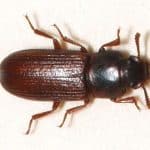Votre panier est actuellement vide !

The brown tribolium of flour
Small reddish-brown beetle, 3.5 mm longThe body is smooth and elongatedThe eyes are very narrow on the sides and have only one or two rows of facets at their narrowest point.The species can also be distinguished from its congeners by the very coarse punctation that adorns the center of its thorax.The vermiform larva can reach 6 mm in length at its full development.It can be distinguished by the two short spikes that terminate its abdomen.The larva is yellow in color, with a cylindrical shape
Latin Name: Tribolium confusum
Description:Small reddish-brown beetle, 3.5 mm longSmooth, elongated bodyEyes are very narrow on the sides, with only one or two rows of facets at their narrowest point.The species is also differentiated from its congeners by the very coarse punctation that adorns the center of its thorax. The vermiform larva can reach 6 mm in length at full development.It is distinguished by the two short spikes that end its abdomen.It is yellow, cylindrical in shape.
Reproduction: The temperature favoring the development of these insects is 20°C to 37°C;they do not develop below 18°C.The females deposit 400 to 500 eggs in scattered groups in the food source.at a rate of 2 to 3 eggs per day. These eggs are sticky and clump around food particles, making them difficult to distinguish.The larvae hatch about 10 days later and feed in this environment; only after 7 or 8 molts do they enter the pupal stage.The duration of the larval stage varies from 22 days to over 100 days, depending on the ambient temperature, humidity and food availability.The pupal stage lasts an average of 8 days.The duration of the complete cycle generally varies between 7 weeks and 3 months. A female tribolium can live up to 2 years and a male up to 3 years.
Habits: The brown flour beetle is a fast-moving insect when disturbed, but it does not fly.Its small size and grinding mouthparts allow it to infiltrate containers and closed packages.Adults and larvae feed on cereal flours; they are unable to perforate unmilled grain. They are found in flour mills, food plants, bakeries and homes where they infest grain and other milled products. When they are present in large numbers, flour turns gray and molds rapidly. They leave an unpleasant odor in food, making it unfit for consumption.Other products can be infested by triboliums: peas, beans, nuts, spices, chocolate, museum specimens such as plants and insects.
Prevention: As with many insects that attack food: Examine all food you bring home to make sure it is free of pests.Make sure the food you buy is fresh.Buy only small amounts of perishable grain products, especially in the summer.Keep excess food in tightly sealed containers(plastic or glass) to prevent the spread of insects to other foods.Do not prolong the storage of food for too long. When these insects are present, the first step is to determine the extent of the infestation and remove all contaminated food. It is important to examine all stored products, even if the packages have not been opened. Finally, treatments can be applied in the home but should be administered by specialists to ensure that all sources of infestation are properly treated.